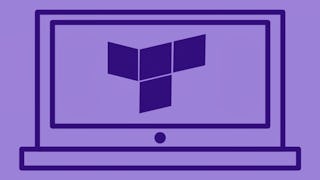This course provides an introduction to using Terraform for Google Cloud. It enables learners to describe how Terraform can be used to implement infrastructure as code and to apply some of its key features and functionalities to create and manage Google Cloud infrastructure.

Gain next-level skills with Coursera Plus for $199 (regularly $399). Save now.

Getting Started with Terraform for Google Cloud

Instructor: Google Cloud Training
6,437 already enrolled
Included with
(58 reviews)
What you'll learn
Define the business need for infrastructure as Code and the benefits of using it in your environment.
Explain the features and functionalities of Terraform.
Use Terraform resources, variables, and output values to create Google Cloud infrastructure resources.
Use Terraform modules to build reusable configurations.
Skills you'll gain
Details to know

Add to your LinkedIn profile
5 assignments
See how employees at top companies are mastering in-demand skills

There are 7 modules in this course
This section welcomes learners to the Google Cloud Fundamentals: Core Infrastructure course, and provides an overview of the course structure and goals.
What's included
1 video
This is an introductory module that covers the business need for Terraform. We’ll start with the basics by providing an overview of infrastructure as code (IaC), which is the basic concept for Terraform. We will explore how Terraform can be used as an IaC tool on Google Cloud and also cover its features and benefits. We’ll then look at how Terraform transforms lines of code into real infrastructure on Google Cloud.
What's included
5 videos1 assignment
In this module, we introduce you to HashiCorp Language and discuss the terms and concepts involved in authoring a Terraform configuration. We also explore some of the important Terraform commands involved in managing the terraform configuration. Upon completion of this module, you will be able to interpret what each code block means, create basic configuration files within Terraform and be able to explain the purpose of a few few important terraform commands and we will also explore what a Validator tool is.
What's included
8 videos1 assignment1 app item1 plugin
In this module, you will explore more about resources, variables, and output resources. We will begin by exploring how to create infrastructure components using resources and then explore how Terraform handles dependencies within resources. While we have been covering resource creation by using hard-code resource arguments, we will explore how you can parameterize a given configuration using variables. We will explore the syntax to declare, define and use them within your configuration. We will then discuss how you can export resource attributes outside the resource declaration using output values. We will then wrap up the module by discovering how you can simplify code authoring using Terraform registry, and Cloud Foundation Toolkit.
What's included
10 videos1 assignment1 app item
You will explore what modules are, how to use them from a public registry, how to use modules to reuse configurations, and parameterize configurations using input variables. You will also explore how to use output values to access resource attributes outside of the module.
What's included
8 videos1 assignment1 app item
The module starts with an introduction to Terraform state. You’ll then learn about the different ways to store Terraform state. Later in the module you’ll explore the benefits of storing the state file in a remote location. While there are many remote locations in which you can store the state file, this module describes how to store it in a Google Cloud Storage Bucket. You’ll wrap up the module by learning best practices for working with state files.
What's included
6 videos1 assignment1 app item
In this final section, we review what's been presented in this course.
What's included
1 video
Instructor

Offered by
Explore more from Software Development
 Status: Free Trial
Status: Free Trial
Google Cloud
 Status: Free Trial
Status: Free Trial Status: Free Trial
Status: Free Trial
Why people choose Coursera for their career




Learner reviews
58 reviews
- 5 stars
72.41%
- 4 stars
22.41%
- 3 stars
5.17%
- 2 stars
0%
- 1 star
0%
Showing 3 of 58
Reviewed on Jul 28, 2024
It gave me good understanding of terraform and how to use it, thank you all.
Reviewed on Dec 6, 2024
Very Nice crisp and clear course, with very good hands on lab
Reviewed on Nov 25, 2024
This course is really Awesome to get familiar with the Terraform and its components. I would strongly recommend if anyone wanted start to know about Terraform with GCP.

Open new doors with Coursera Plus
Unlimited access to 10,000+ world-class courses, hands-on projects, and job-ready certificate programs - all included in your subscription
Advance your career with an online degree
Earn a degree from world-class universities - 100% online
Join over 3,400 global companies that choose Coursera for Business
Upskill your employees to excel in the digital economy
Frequently asked questions
To access the course materials, assignments and to earn a Certificate, you will need to purchase the Certificate experience when you enroll in a course. You can try a Free Trial instead, or apply for Financial Aid. The course may offer 'Full Course, No Certificate' instead. This option lets you see all course materials, submit required assessments, and get a final grade. This also means that you will not be able to purchase a Certificate experience.
When you purchase a Certificate you get access to all course materials, including graded assignments. Upon completing the course, your electronic Certificate will be added to your Accomplishments page - from there, you can print your Certificate or add it to your LinkedIn profile.
Yes. In select learning programs, you can apply for financial aid or a scholarship if you can’t afford the enrollment fee. If fin aid or scholarship is available for your learning program selection, you’ll find a link to apply on the description page.
More questions
Financial aid available,

